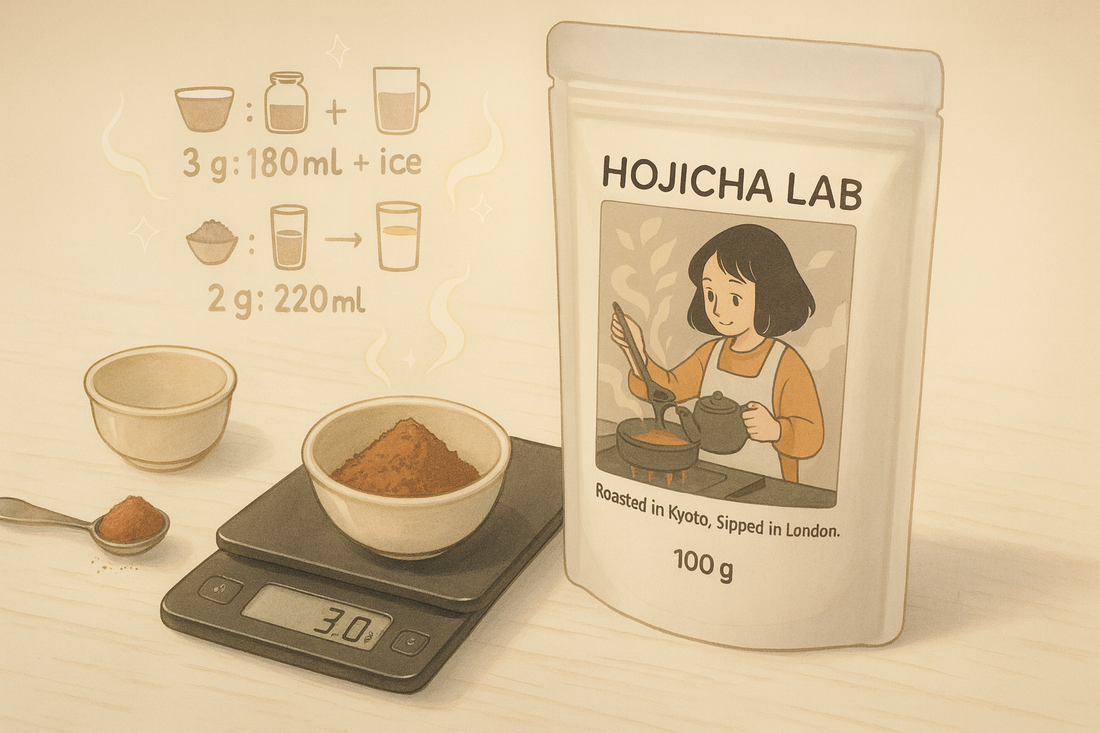
How Much Hojicha Powder Per Serving? Ratios for Hot, Iced & Baking
Dial in your perfect cup (or bake) with clear gram-to-ml ratios you can trust. As a quick guide, 1 level teaspoon ≈ 2 g hojicha powder; ½ tsp ≈ 1 g.
Pro tip: Cold drinks and thicker milks mute flavour; use a little more powder for iced lattes and non-dairy milks. Always make a quick slurry (powder + splash of warm water) to prevent clumps.
Hot Latte Ratio
Standard: 3 g (≈1½ tsp) hojicha powder to 200 ml hot milk. Heat milk to ~65–70 °C (latte temperature), not boiling.
- Whisk 3 g powder with 30 ml warm water (50–70 °C) to make a smooth slurry.
- Top with 170 ml hot milk (dairy, oat, or your favourite). Sweeten to taste.
Adjust: Mild 2 g • Strong 5 g for the same 200 ml. For a shorter, punchier cup, use 3–4 g with 150 ml milk.
Iced Latte Ratio
Standard: 4 g (≈2 tsp) to 180 ml cold milk + ice (6–8 cubes).
- Make a slurry: 4 g powder + 30 ml warm water, whisk until glossy.
- Add 180 ml cold milk; shake in a jar or use a handheld frother. Pour over ice.
Why more? Cold and ice dilute both body and aroma. Use 5–6 g for café-style strength or when using lighter milks.
Straight Brew (Water Only)
Standard: 2 g (≈1 tsp) to 220 ml hot water. Hojicha is roasted, so hotter water is fine.
- Whisk 2 g with a splash (20–30 ml) of hot water to de-clump.
- Top to 220 ml with 85–90 °C water. Sip as a toasty, amber brew.
For a mug (~300 ml), use 3 g standard, 4–5 g strong.
Smoothies
Standard: 3 g (≈1½ tsp) per 300 ml smoothie base (e.g., banana + oat milk). Blend powder with the liquid first for 5–10 seconds, then add fruit and ice.
Adjust: 2 g for subtle malted notes; 5 g if pairing with cacao/peanut butter.
Baking Ratios
Hojicha’s toasted caramel notes shine in cakes, cookies, and brownies.
- Per 250 g flour: Mild 10 g • Standard 15 g • Strong 25 g.
- Cake batters: Sift powder with the flour to prevent specks.
- Cookies/brownies: Mix powder with sugar to disperse evenly.
Expect a gentle brown hue and cosy aroma. Stronger additions pair well with chocolate, caramel, and nuts.
At-a-Glance Strength Table
| Method | Mild | Standard | Strong | Notes |
|---|---|---|---|---|
| Hot Latte (per 200 ml milk) | 2 g (≈1 tsp) | 3 g (≈1½ tsp) | 5 g (≈2½ tsp) | Slurry first; 65–70 °C milk. |
| Iced Latte (180 ml milk + ice) | 3 g (≈1½ tsp) | 4 g (≈2 tsp) | 6 g (≈3 tsp) | Cold mutes flavour—use more. |
| Straight Brew (water) | 1.5 g (≈¾ tsp) in 220 ml | 2 g (≈1 tsp) in 220 ml | 3 g (≈1½ tsp) in 220 ml | 85–90 °C water. |
| Smoothie (per 300 ml) | 2 g (≈1 tsp) | 3 g (≈1½ tsp) | 5 g (≈2½ tsp) | Blend with liquid before fruit. |
| Baking (per 250 g flour) | 10 g (≈5 tsp) | 15 g (≈7½ tsp) | 25 g (≈12½ tsp) | Sift with dry ingredients. |
Conversion guide: 1 level teaspoon ≈ 2 g hojicha powder (densities vary slightly by grind).
FAQ
How many teaspoons is a serving?
For a hot latte, a standard serving is about 1½ teaspoons (≈3 g) to 200 ml milk. For iced lattes, use 2 teaspoons (≈4 g) to compensate for ice. Straight brews are typically 1 teaspoon (≈2 g) in ~220 ml water.
How do I avoid clumps?
Always make a slurry: whisk the powder with a small splash of warm water (50–70 °C) until smooth, then add milk or more water. A handheld frother, small whisk, or shaker jar works well. Sifting the powder first helps too.
Does milk type change the ratio?
Yes. Creamier milks (whole dairy, barista-oat) carry flavour better, so your usual ratio works. Lighter milks (almond, rice) and very cold drinks may taste softer—add +1 g to your normal amount for the same intensity.